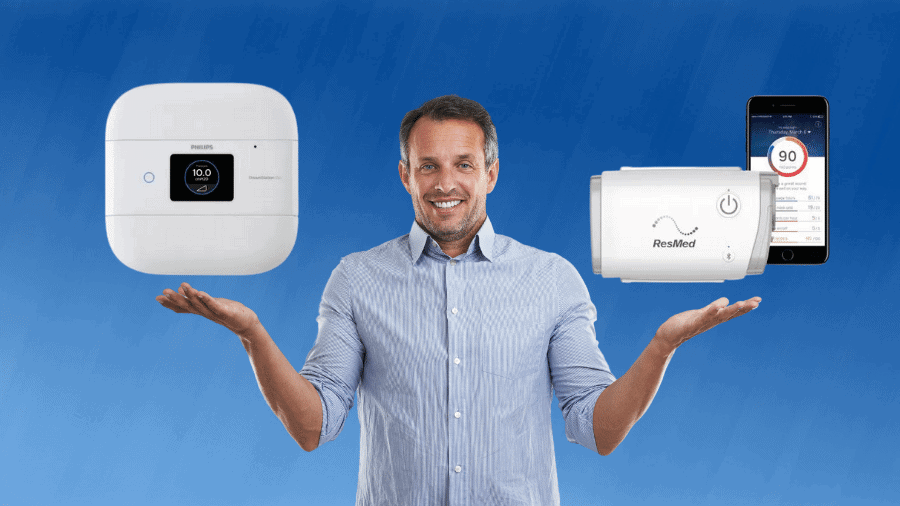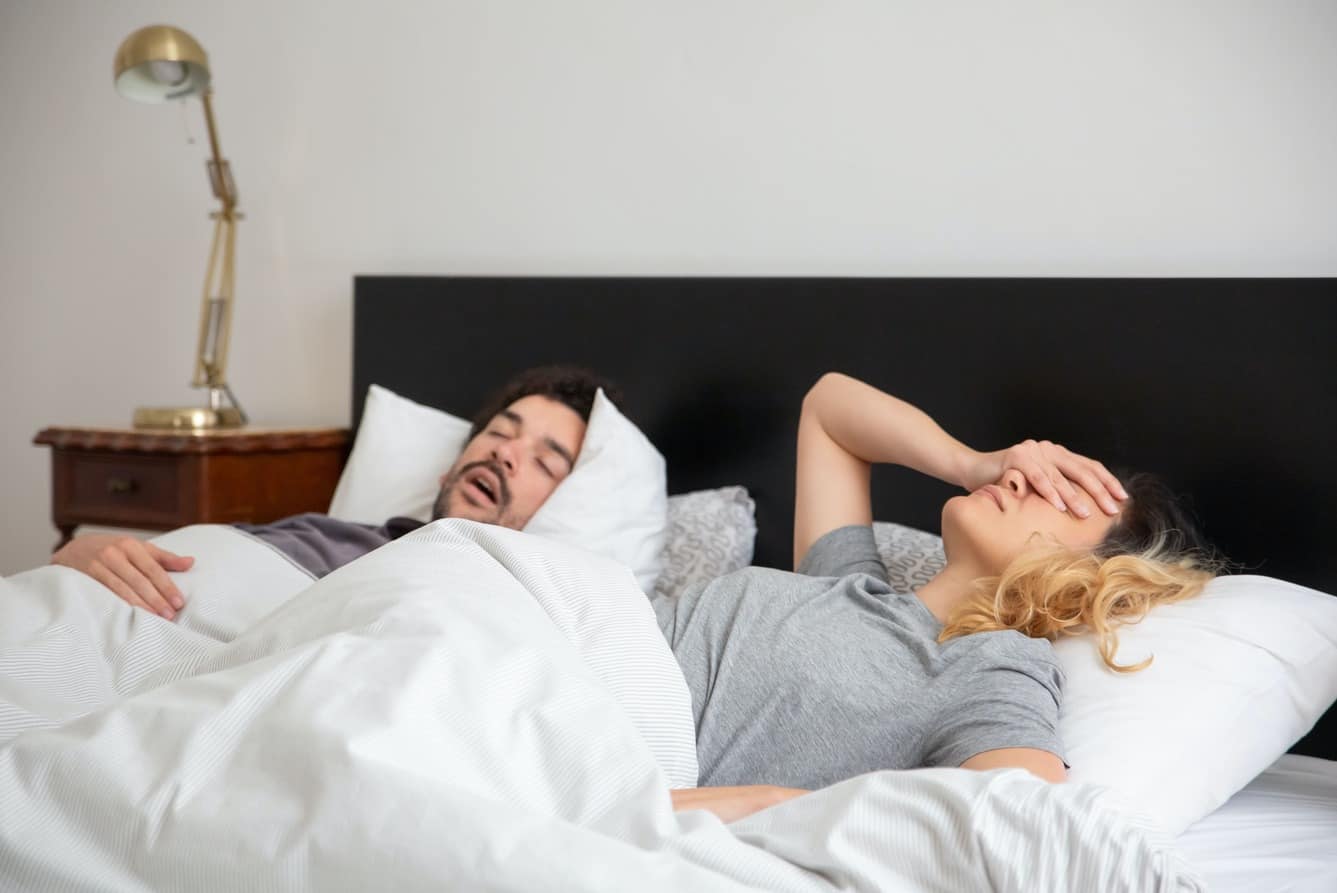The DreamStation Go auto CPAP from Philips Respironics* and the AirMini auto CPAP from ResMed are top-selling travel CPAP machines. Since their market release, both devices have gone through refinements and changes in their options.
*The DreamStation Go has been recalled as of June 2021. View the official Philips recall website for the latest updates.
Early on, many reviews put them neck and neck, with some giving a slight edge to the DreamStation Go due to AirMini’s limited compatibility with only a few ResMed CPAP masks.
At this point in the product cycle, though, the DreamStation Go has pulled far ahead of the AirMini and is the travel CPAP machine that delivers the most value to any sleep apnea user.
Reason #1 – Validated for Everyday Use
The DreamStation Go and the AirMini are advertised as travel CPAP machines. The DreamStation Go, however, has been tested and validated for daily use. Yes, that’s right. The DreamStation Go could be your 365-night-a-year machine for sleep therapy, at home, and on the road.
The primary feature that differentiates travel CPAP systems from home systems is the motor. Travel motors are of necessity smaller and may not be as robust as the motor found in a full-size machine. As a result, pressure adjustments needed during sleep may occur more slowly.
The AutoPAP modes on many travel devices work best for people who do well within a narrow range of pressure during the night and do not require the machine to adjust too often.
This limitation can be a real concern for a prolonged time away from home. But it’s not going to be a worry with the DreamStation Go. It will perform just as well as your home system on a three-week cruise or ten days with the grandkids.
Reason #2 – Humidification
When first released, the DreamStation Go did not have a humidification option while the AirMini came with a waterless humidification system using heat moisture exchanger (HME) discs (HumidX and HumidX Plus).
Consequently, early in the product cycle, the everyday usability advantage of the DreamStation Go was negated by the lack of humidification. A heated humidifier is now available for the DreamStation Go. The humidifier even works with tap water during travel, so you don’t have to lug distilled water along.
Heated humidification is substantially better than HME technology at keeping the water vapor content in the CPAP flow closest to that of normal breathing. HMEs, such as the HumidX, work by collecting moisture from exhaled breaths into a sponge-type material. The flow from the CPAP machine passes through the sponge and picks up moisture for the next inhalation.
HMEs do not add as much humidity to the very dry air generated by the CPAP machine the way an actual humidifier does. A heated humidifier is the best choice for optimal humidity and for better matching what the airways and lungs prefer.
The AirMini circuit requires a proprietary adaptor so that the HumidX connection can fit. HMEs must also be replaced at regular intervals for optimal humidification. They are less effective than usual if the user is in a dry climate. HMEs are an option worth having for short stints, say one night away. They are not a good choice for numerous nights.
The DreamStation Go’s heated humidifier works with distilled water or tap water. It has a small reservoir, so the software factors in settings and ambient conditions with expected sleep duration to adjust the humidifier’s settings to stretch out the low volume of water for the anticipated sleep duration.
Reason #3 – Compatibility with Circuits and Masks
The DreamStation Go does not use proprietary connections. It allows you to use your everyday mask, regardless of brand or mask type.
Any CPAP circuit will connect to the DreamStation Go. Several sizes of circuits can be connected and selected in the settings menu. Being able to set the circuit size in the machine is vital as it allows the device to alter flow rates, reliably measure leaks, and optimally adjust settings.
From launch, ResMed drew some eye-rolling by choosing to use proprietary connections for the circuit and the mask. The medical device world has some long-existing standard connection sizes for respiratory equipment. When companies choose to deviate, the reasons are only self-serving. It’s not a consumer-friendly choice.
The AirMini initially was only compatible with two ResMed masks. Not only was the AirMini not compatible with all ResMed masks, but AirFit P10 nasal pillow users still had to buy a new mask, the P10 for AirMini. At launch, there were also no full face masks validated for use with the AirMini.
Fast-forward to today, ResMed has verified three of their full face masks for use with the AirMini, but none of them are usable with the HumidX HME. A 3rd party connector is available to connect to any mask, but in doing so, you lose the HumidX HME option for all masks.
The AirMini circuit connection is also proprietary, so using standard circuitry is not a choice.
In short, ResMed has made it difficult for users to determine what is compatible with the AirMini. For many people, using the AirMini on a trip necessitates using a different circuit and, more importantly, a different mask from the one they use night after night.
ResMed has a fantastic line of mask choices for CPAP wearers, but for people not already hooked into the ResMed ecosystem, the AirMini introduces quite a bit of confusion and chaos.
Reason #4 – Battery and Power Supply
The DreamStation Go has an OEM battery option. The battery connects seamlessly to the machine and will last up to 13 hours, depending on settings. The DreamStation Go also has a USB port so you can use it to charge your phone or other electronic devices.
The power supply is built inside the DreamStation Go. With the OEM battery and humidifier disconnected, the DreamStation Go is roughly a 6×6 inch square that weighs two pounds. The power supply is internally tucked away in that square, making it one less part to pack.
While the AirMini weighs only 0.66 pounds, that feather-light statistic does not include its power supply. The power brick plugs into the AirMini and adds another pound and another piece to pack.
A third-party battery brick (Pilot 24 Lite) is now available for the AirMini. It will last for one or two nights of sleep, depending on the settings and duration of sleep. It costs a bit more than the DreamStation Go OEM battery. The DreamStation Go’s battery has been tested and verified by Philips Respironics, and the machine will display the current battery capacity.
Reason #5 – On-Board Controls and Data Capture
The DreamStation Go has a screen. The AirMini does not.
You can toggle the AirMini on and off via a smartphone app. The AirMini does have an on/off button on the front of the machine, and I’m sure that is what people use most of the time. But that on/off switch is the only available onboard device control there is. The only way to adjust settings or view data on the AirMini is to connect it via Bluetooth to a smartphone application.
The DreamStation Go has a touch screen that is intuitive enough. Viewing overnight data on the screen is not difficult. You can make setting changes via the touch screen. The DreamStation Go can also dump data into the DreamMapper application.
Not only can you not view data on a screen with the ResMed, but you also cannot pull off more significant chunks of information to an SD card or through a data port. The DreamStation Go has a MicroSD slot to capture waveform data for providers or motivated CPAP wearers to review much more information about the overnight events than a summary AHI and leakage report.
Winner: DreamStation Go






